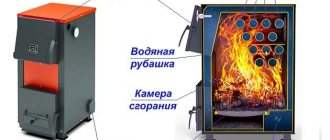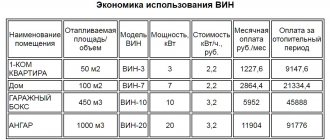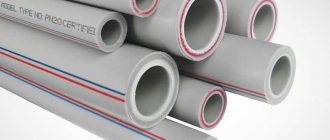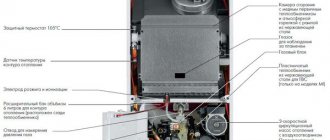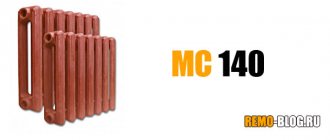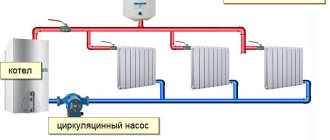Advantages and disadvantages of a water heating system
The main disadvantage of water heating in a private home is the need to purchase a large number of different materials. Namely: pipes, shut-off valves, fittings, radiators, boiler and circulation pump. The latter is not used in all systems.
And other shortcomings that can be described as nonsense if the owner of the house is indifferent to his home:
- Water leaks during operation. Today this situation is rare because plastic pipes have been replaced by plastic pipes. But even they sometimes leak at the junctions with other materials. These are already claims against the installation manufacturer.
- The water inside the system may freeze if it is not drained for the winter. This situation is for houses that are not used during the cold season.
Plastic pipes have solved many problems
Water heating has more advantages, which is why the majority of developers of new houses choose it:
- uniform distribution of heat throughout all rooms;
- installing one heating boiler makes it possible to control the process from one place;
- all equipment, except radiators, and piping can be made hidden. That is, organize a boiler room in the office space, and hide the pipes in grooves on the walls or in the floor. Using a heated floor system generally solves the problem of hidden installation. Even the radiators will not be visible;
- The coolant temperature does not exceed +95°C. And the surface of the batteries heats up to +65°C. You can’t get burned on them; dust doesn’t burn on them;
- water heating produces soft heat.
Heating system with hidden pipe wiring
Choosing heating equipment in a private house
The most important equipment that properly provides water heating in a private home is a boiler.
When purchasing a boiler, a power value of 1 kW per 10 sq.m of space that is heated is usually accepted.
It is also taken into account that the ceiling height is taken to be no more than 3 meters. In addition, the volume of the room, the level of insulation of the house itself, the size of the windows and additional heat consumers are taken into account.
So, given the area that is heated, the boiler power will be equal to:
- 60 – 200 sq.m. – up to 25 kW;
- 200 – 300 sq.m. – 25-35 kW;
- 300 – 600 sq.m. – 35-60 kW;
- 600 – 1200 sq.m. – up to 100 kW.
To equip water heating in a country house or in a private house, you can choose an electric boiler with an area of 30-1000 sq.m. power 3-105 kW. But electric boilers have disadvantages - the high cost of electricity, constant interruptions and fluctuations in electricity, and insufficient power.
Electric boiler
The pipeline must also be selected carefully. Pipes made of different materials are used, each of which has its own advantages and disadvantages. In the old days, steel pipes were the most common. But today they are used less often. After all, such pipes are more susceptible to corrosion processes.
That is why nowadays stainless steel or galvanized pipes are more often used.
Copper pipes are also gaining popularity. They are able to withstand high temperatures and are durable in themselves, which is why copper pipes are the most reliable. But they are not cheap either. In addition, recently it is increasingly possible to find water heating in a wooden house with polymer pipes. Such pipes are made of metal-plastic or propylene (with the participation of aluminum). Pipes made from such materials are durable, resistant to corrosion, and no sediment is deposited inside them. But they have a fairly high coefficient of expansion when heated.
Steam heating in a private house
Piping the boiler with copper pipes
Features of a water heating system
From the name itself it becomes clear that the coolant in this case is water. This is the environment that accumulates thermal energy well and releases it easily. It has a high heat capacity, expands when heated, but contracts poorly when pressure increases. Water density is 950 kg/m³. The principle of operation of water heating is quite simple. The water is heated in the boiler, and then moves through pipes to the radiators, where it gives off its heat, and returns through the return circuit to the boiler.
How the coolant moves through the heating system
The main task of the heating assembly is to force the coolant to move along the circuit. Therefore, there are two types of heating systems: with natural circulation of coolant and with forced circulation. In the first case, water moves through the pipes under the influence of physical laws, when the warm medium rises up and the cold medium goes down. In the second, movement occurs due to the operation of the circulation pump. But more on that below, and now let’s look at what materials and equipment are best to choose for installing water heating.
Two-pipe associated heating system diagram
The two-pipe scheme is the highest quality from a control point of view. In it, heating devices are connected to pipelines in parallel. This principle makes it convenient to regulate the temperature and allows you to turn off individual devices for prevention and repair.
Part of the coolant from the supply pipeline enters the radiator, the bulk moves to subsequent heating devices. This type of piping is applicable for autonomous and centralized heating systems. Installing thermostatic heads can completely automate the heating control process.
Basic elements of water heating
The water heating system includes:
- heat generator, also known as a boiler or furnace;
- pipes;
- radiators;
- circulation pump;
- expansion tank.
Complete set: boiler, radiators, pump and expansion tank
Heating boilers
Before purchasing and installing a heating boiler in a private home, you need to calculate its power. This indicator reflects the amount of thermal energy supplied. And the larger the area of a private house, the more powerful the equipment must be installed.
Gas generator for heating a private house
It is easy to calculate the power of the unit. To do this, you need to know one ratio - for 10 m² you need 1 kW of thermal energy. This takes into account that the height of the ceilings in the rooms is no more than 3 m. But it is necessary to understand that this ratio will act differently in different climatic regions. Therefore, SNiPs contain climate coefficients.
| Region | Northern | Middle lane | Southern |
| Coefficient | 1,5-2,0 | 1,0-1,2 | 0,7-0,9 |
For example, the total area of a private house located in Murmansk is 100 m². The boiler power is determined as follows:
- 100 / 10 = 10 kW;
- 10 x 2 = 20 kW , where “2” is the northern coefficient.
Liquid fuel boiler assembly
Now, regarding the classification. Heating units are mainly divided according to the type of fuel used: gas, electric, solid or liquid fuel. If gas is installed in the house, then this is the best option. All other types are considered taking into account what is beneficial. If the power supply is inconsistent or the network voltage is weak, then it is better to give preference to solid fuel boilers. By the way, the latter are not only wood-burning structures, they are modern pellet options, which have wider functionality and higher efficiency.
Solid fuel wood boiler in operation
Attention! Purchasing a boiler is not cheap, so fireplaces and kitchen stoves in which a heat exchanger is installed can be used as heating generators.
Electric heating boiler
Related article:
Long-burning wood-fired boilers for the home. From this publication you will learn everything about wood-burning boilers, their types and nuances of use.
Pipes
Everything is simple here - you only need to use the plastic version. Pay attention to its temperature limit for use. Because there are pipes for cold water and for hot water. In heating, the second position is used.
Plastic pipes for heating
You can talk about the diameter of the pipes only after a full calculation of the system. But first we can say that material with a diameter of less than 40 mm cannot be used for the supply and return circuits. Radiator connections are products with a diameter of 20-25 mm.
Related article:
Heating pipes: which ones are better. Varieties of products, their advantages and disadvantages, how to choose the right diameter, how to insulate - you will find all this and much more in our publication.
Radiators for heating
Manufacturers today offer four types of heating batteries:
- cast iron,
- steel (tubular or panel),
- aluminum,
- bimetallic (steel pipes inside, aluminum on top).
Cast iron radiator - accordion
Related article:
What heating radiators are best to install in an apartment. In this review we will look at the types of radiators, their advantages and disadvantages, popular models and manufacturers.
Each type has its own pros and cons. For example, cast iron heats up slowly, but retains heat for a long time. Aluminum heats up quickly, gives off the most thermal energy, but quickly corrodes. In this regard, the best option is bimetallic or steel, as the golden mean.
Steel tubular radiator
It is important to calculate the required number of battery sections, because this value determines how much heat will be released into the rooms of the house. It is not difficult to do the calculation yourself. To do this, you need to know the area of the room, the average heat transfer value of one section, and also take into account the ratio of the area of the room and the heat transfer from the radiator. The latter is the range of 60-200 W depending on the climate region.
Aluminum model with the highest heat output
For example, the area of a room is 20 m², the average heat transfer value of one section is 170 W, the ratio is taken to be 100 W. The last two indicators can be found in SNiPs. Now we carry out the following mathematical operations.
- 20 x 100 = 2000 W of heat will be required to heat the room;
- 2000 / 170 = 11.76 pieces or 12.
That is, it turns out that in order to heat a room of 20 m², you will need a radiator battery with 12 sections. Of course, this is an approximate calculation, because the ceiling height and battery type were not taken into account.
Bimetallic batteries with high heat dissipation efficiency and long service life
| Cast iron | Steel | ||
| pros | Minuses | pros | Minuses |
| High heat capacity | High specific gravity | High strength | They are afraid of water hammer |
| Long service life | Exclusive models are very expensive | High heat dissipation | In the absence of water, corrosion processes begin to occur |
| Withstands pressure up to 22 bar | Unpresentable appearance of accordions | Two types: tubular and panel | |
| Low price | Low impact strength | Low price | |
| Requires a small volume of coolant | |||
| Aluminum | Bimetallic | ||
| pros | Minuses | pros | Minuses |
| Highest heat output | They are afraid of water hammer | Withstand high pressure | Not the highest heat transfer compared to other models |
| Low specific gravity | Subject to corrosion | Easily cope with water hammer | Not the lowest price |
| Short service life | Very easy installation | ||
| High resistance to corrosion processes | |||
Especially for our readers, we have developed a convenient calculator for calculating the number of radiator sections.
Calculator for calculating the number of heating radiator sections
Expansion tank
Before heating a private house, you need to think through all the positions so that the end result does not disappoint. Therefore, choosing the type and volume of the expansion tank is the most important component of the installation process. Its only purpose is to absorb water, the volume of which has increased due to heating. An additional function is to remove air from the system.
Expansion tanks for heating are always red
The expansion tank can be open or closed. The first is a regular container with an open top end. That is, water comes into direct contact with air. It is usually installed above all other heating units. Warm water gradually evaporates through the open neck, so it will need to be added periodically. The second is a sealed vessel, inside of which there is a rubber membrane. Stretched by water, it creates pressure inside the system, which helps the movement of the coolant. Typically, a closed model is installed with a circulation pump. There is no mandatory requirement to install high. That is, the tank is installed in any convenient place.
As for its volume, this figure is 15% of the coolant volume. The latter is not easy to calculate. You will have to find out the volume of water that is placed in the boiler (in the passport data), in the radiators (ibid.), in the pipes. The latter will need to be calculated using the formula for the volume of cylindrical figures, taking into account the length and diameters of the pipes. It is much easier to use a calculator specially developed by our team, which takes into account all the complexities of the calculation.
Calculator for calculating the volume of an expansion tank for a heating system
Circulating water pump for heating a private house
This device is used only in systems with forced circulation of coolant. It is convenient because pressure is created inside the pipework, which increases the speed of water movement. In this way, the coolant is evenly distributed over the radiators.
Circulation pump for moving coolant
The main parameter of a water pump for heating a private house is performance. To calculate it, the formula is used: Q = N/1.16x(tout-tin), where N is the power of the generator, tout and tin are the coolant temperatures at the outlet and inlet of the boiler, “1.16” is the heat capacity of water. Temperature difference is a parameter that needs to be measured. But it is impossible to do this if the heating system is not yet turned on. Therefore, there are average indicators.
| Heating type | Radiator | With installation of convectors | Warm floor system |
| Temperature difference, C | 20 | 15 | 5 |
How to install the pump correctly
Circulation pump performance calculator
Circulation pump pressure calculator
What does a water heating system consist of?
Before heating a private house, you should calculate the required amount of material. And this is impossible to do without knowing what elements the system consists of. There are 5 main components:
- boiler;
- pipes;
- radiators;
- circulation pump (not always);
- expansion tank.
An expansion tank is necessary for any heating system
Related article: Long-burning solid fuel boilers with a water circuit. Advantages and disadvantages, operating principle, selection criteria, review of the best manufacturers and models, how to make a boiler with your own hands - read in our publication.
The role of the boiler in the heating system of a private house
The boiler is the main unit of the system. With its help, the coolant is heated. Boilers can be solid fuel (wood, coal, pellets or peat), gas or electric. Gas boilers are considered more economical than others, but even with today’s level of gasification, “blue fuel” has not reached every corner of vast Russia.
Important! The boiler, regardless of the type of fuel, requires constant attention and periodic inspections. Only in this case can you be sure that the heating system will not fail at the wrong time.
The heating boiler is the heart of the entire system. He needs to be constantly monitored
Before installing a heating boiler in a private house, you need to calculate the power required to heat the entire living area. For these purposes, we suggest using the convenient calculator below.
Calculator for calculating the required boiler power
Pipes are the circulatory system for heating a home.
Pipes play the role of arteries through which the coolant vital to the heating system runs. For installation, seamless, welded pipes with a safety margin of 16 atm are used. Lightweight materials are also used - polypropylene, cross-linked polyethylene. Today we offer polypropylene products that are not afraid of frost. According to the manufacturer, even if the water in such lines freezes, it is impossible to defrost the pipes.
Various materials are used for the installation of heating system lines.
Why are water pumps installed for heating a private home?
The circulation pump forces the coolant to move through the pipes. When installing the pump, the boiler, even if it is installed in the basement of a two-story house, will work as expected - heated water will still flow through the system. A correctly selected circulation pump in terms of power and performance will ensure stable operation of the system and an equally comfortable temperature in all rooms. We have developed convenient and visual calculators especially for our readers.
The circulation pump creates the movement of coolant along the lines
Calculator for calculating the required pressure of the circulation pump
Circulation pump performance calculator
Selecting radiators for a private home
Just yesterday, cast iron radiators were installed in private and apartment buildings. There was no need to talk about aesthetics in appearance. All that could be done was to paint the sections to match the color of the walls. Today the range of radiators on the Russian market is extensive. Aluminum or bimetallic radiators are popular among the population. Their heat transfer is at a high level, and their weight is disproportionately less than that of cast iron. And the cost is lower. Both assembled radiators and individual sections are available for sale, which can be assembled independently to any length.
Sectional radiators are the most popular type
Expansion tank: why is it needed?
Water expands when heated. And if you make a closed system without coolant outflow, the pipes will simply burst. The same applies to the reverse effect of volume reduction after cooling. In open systems, periodic addition of water to the expansion tank is required. After all, it evaporates during operation. If you do not fill it in time, when it cools, the volume of the coolant will decrease and air will enter the system. If there is a pump, this is fraught with minor troubles, but if it is not there, the system will “stop” and the water circulation will stop, which will lead to the radiators cooling and the coolant in the heater boiling. To calculate the minimum required volume of the expansion tank, use the calculator below.
In closed systems, the expansion tank may be located at the bottom
Calculator for calculating the minimum volume of an expansion tank
What is a thermal circuit and how is it installed
A thermal circuit is a closed line that starts at the supply from the heating boiler and ends at the “return”, passing through the radiators. Depending on the equipment and functionality of the boiler, the power and performance of the pump, there may be 2 or 3 circuits. This depends on the size of the area of the heated premises.
Do-it-yourself heating installation in a private home is a labor-intensive process that requires accuracy in calculations during planning and strict adherence to the calculated parameters during the work process. However, even a home master without professional skills can do this. The main thing here is attentiveness and strict adherence to the rules.
“Warm floor” is an excellent way to heat a room
Classification of water heating systems
As mentioned above, heating is divided according to the method of movement of the coolant into: natural circulation and forced.
Heating system with natural coolant circulation in a one-story house
Let’s immediately make a reservation that a heating system with natural circulation is best used in one-story houses. The thing is that the coolant cannot rise high even at a temperature of +95°C. Of course, no one limits the height of the distribution; it’s just that the system itself will work ineffectively.
Schematic diagram of heating with natural circulation of hot water
The essence of natural circulation is the movement of water under the influence of the laws of physics. But there is one nuance here that you need to know when installing heating yourself. This is the slope of the horizontal contours from the boiler towards the radiators and from the radiators to the boiler. This figure should be at least 0.5%. That is, this is enough to force the water to move by gravity.
Attention! The advantage of this scheme is complete independence from electricity.
What you need to pay attention to when installing heating without a pump:
- The boiler must be located in the lowest place relative to all pipework. The optimal height difference is 0.5÷1 m.
- The expansion tank is installed above the entire pipework. The height difference is up to 0.5 m.
- The riser leaving the boiler must be directed vertically upward.
- The speed of coolant movement in the system must be no less than 0.1 and no higher than 0.25 m/s. To achieve this, it is necessary to accurately calculate the diameter of the pipes used, taking into account the temperature of the water at the outlet and inlet.
- If heating of this type is equipped with a closed expansion tank, then it is installed at the level of the boiler. In this case, it is necessary to install an air vent into the system, which must be installed at the highest point of the pipe distribution.
Scheme with forced water circulation
Heating diagram for a one-story house with forced circulation of coolant
This scheme differs from the previous one not only in the presence of a pump, but also in the location of the pipes. There is no need for installation at an angle. This is very important for those who are assembling a heating circuit for the first time.
But there is one very important nuance in this system.
Attention! The pump must be installed on the return circuit near the boiler. It is in this area that the coolant temperature is lowest. And this is important for the pump, or more precisely, for its rubber gaskets and cuffs, which simply cannot withstand high temperatures. They will begin to shrink and burst, which will lead to leaks and failure of the pumping unit.
Correct pump installation location
It should be noted that the heating scheme with forced circulation can be used not only for one-story houses. If you accurately calculate the power of the circulation pump, it will easily pull several floors. Although experienced plumbers recommend installing several boilers with separate pumps for a large house with several floors.
Related article:
Heating a country house: options and prices. A separate review provides a comparative analysis of various heating methods with tips and recommendations.
Heating with forced circulation
So, we see that systems with natural circulation of liquid have a number of rather significant disadvantages. An alternative to them are systems with forced circulation, which use additional equipment that increases the flow of coolant in the system. Namely the circulation pump.
Yes, this type of water heating at home will be more expensive and complex, but you get many advantages:
- Possibility to heat a large room. We have already said that natural circulation is not suitable for large houses. If you are the owner of just such a thing, then your only option is a forced circulation system.
- Complication of the system. By installing a pump, you do not depend on such an indicator as pressure. Therefore, what was an obstacle in a gravity system is not a problem in a forced one. For example, you can now increase the number of pipe bends if the layout of your home requires it.
- Use of smaller pipes. Agree, the neat appearance of the heating system is not the last indicator that is worth paying attention to.
- Less dependence of heating quality on the presence of air in the system. With self-circulation, the entry of air into the system would significantly complicate the transportation of coolant through the pipes. A forced system solves this problem, but in the case of installing metal pipes, special expansion tanks with air vents and fuses should be used in order to avoid corrosion of the system.
- Possibility of using more wear-resistant and lightweight plastic pipes.
- Concealed installation of pipes is possible. You can hide pipes in screeds and walls without any problems
Radiator connection diagrams
For ordinary people who do not think about how radiators are connected in their own home, it does not matter what circuit is used. The main thing for them is warmth in the house. But, as practice shows, it is the connection diagram of radiator batteries that affects the quality of heat transfer. And there are two schemes: one- and two-pipe.
How to make a one-pipe heating system for a private house with your own hands
First of all, you need to understand why it is called that. In essence, a single-pipe is a ring with a boiler in the center. The pipes are laid close to the floor in a circle, with batteries connected to them. Each of them takes the coolant from one side from the lower pipe and squeezes out already cooled water into the same pipe from the other opposite pipe (lower).
Let's face it, it's not the best option, because it has one significant drawback. The radiators far from the boiler receive coolant with a significantly reduced temperature. That is, the batteries closest to the boiler will be hot, the ones farther away will be warm. This means that some rooms will be cool.
Single-pipe with connection of radiators to one circuit
But if a private house is small with 3–6 rooms, then a single-pipe heating system in it is justified due to the ease of installation with your own hands, plus a small number of pipes, shut-off valves and fittings. That is, this is the most economical option in terms of construction. Although the scheme and procedure for installing single-pipe heating are considered simple, the responsibility of the operations carried out is still high. This is especially true for systems with natural coolant circulation. Here it is important to accurately observe the slope of the pipework.
Two-pipe scheme
This water system is more complex for installation work, plus it uses more materials. But it works much better than a single-pipe one. Purely structurally, the layout of the pipes in it consists of two circuits: supply and return. It should be noted that both pipelines are blind and are connected to each other only through radiators and a heating boiler. From the names themselves, it becomes clear that heated coolant is supplied to the radiators through the supply circuit, and cooled coolant is discharged to the boiler through the return circuit.
In this case, radiators can be connected to the supply circuit in different ways. Option one is a circuit with lower wiring. This is when the coolant supply pipe runs along the floor with a connection to the upper radiator pipes. The return is carried out right there, but with a connection to the lower pipes of the heating batteries.
Two-pipe with bottom wiring
The second option is a top-wiring scheme. This is when a pipe riser is drawn upward from the boiler, which goes into a circuit that distributes the coolant to the radiators. The latter is mounted under the ceiling or in the attic. The return line is installed, as usual, at floor level or in the basement.
Attention! All pipes in unheated rooms (attic) are thermally insulated.
It is necessary to indicate that the upper distribution is two options for distributing pipes from the riser.
- When one horizontal pipe is laid, and risers of small diameter pipes are lowered from it to the radiators from above.
- When a collector is installed on the riser, from which each battery has its own circuit. Such a system is called a collector system. Although people often hear other names - spider or ray circuit. By the way, experts believe that this is the best option for a private home if the task is to install heating yourself. It is the most effective, but also the most expensive in terms of pipe consumption.
Two-pipe with top wiring
Pay attention to the photo above. It clearly shows sections of the heating system, where “1” is the general circuit, “2” is the main riser from the boiler, “3” is a horizontal section with a slope, usually located in the attic. “4” are risers that supply coolant to the radiators. “5” are risers that remove coolant from the batteries and “6” is the return line.
And there are two more types of two-pipe systems - with horizontal wiring and vertical. The first is used for one- or two-story buildings, the second for multi-story ones. A distinctive feature of the second before the first is the presence of a high riser, from which supply circuits are distributed among the floors.
Water heating of a private house: pros and cons of the system
Like any type of heating, water heating has supporters and opponents. But our job is not to take one side, but to carefully consider all the parameters. Let's look at the advantages of heating your home with water.
| Advantages | Flaws |
| The heat capacity of water is 4,000 times higher than the same parameter of air - this is a proven physical property | Do-it-yourself heating installation and subsequent operation require more effort than other types of heating |
| Installation and subsequent operating costs are relatively low | Monitoring the coolant level and periodic inspections of the water heater are mandatory |
| This heating allows the use of any fuel or electricity as a heater. | If this is heating a country house, the water is drained in the winter when the heater is not in use. Otherwise, the pipes will defrost (the problem can be solved by replacing water with antifreeze). And if there is no water, then interaction with air leads to accelerated corrosion of the metal pipes inside |
| Pipes are laid under the floor or hidden by a suspended ceiling |
The first thing to think about is the placement of heating devices for the heating system
DIY heating schemes in a two-story private house
Two-story private houses are the most frequently erected buildings today. Therefore, a large number of people are faced with heating issues, or more precisely, the choice of its scheme. It is recommended to use a vertical two-pipe installation with either natural coolant circulation or forced circulation.
Natural circulation scheme
This scheme is a boiler in the basement, from which a riser is led to the attic. There, pipes are routed through radiators, which are usually located on top of each other on the second and first floors. That is, it turns out that two radiators on two floors are connected to each other and form one riser, which is connected to the return circuit in the lower part.
Floor-by-floor vertical movement of coolant to the boiler
It is clear that with such a scheme, the main thermal energy will be given to radiators on the second floor. But the difference will not be significant, so it will not be felt much.
Forced circulation circuit
In this case, it is necessary to organize the wiring so that it is horizontal on each floor. That is, both the supply and return circuits are laid under the heating radiators. Moreover, each radiator is connected to both the first and the second.
The coolant is distributed across floors through a small riser, the height of which is limited by the floor of the second floor. That is, it will be a continuation of the supply circuit on the second floor. At the first, a branch is made from it towards the horizontal wiring.
Heating scheme on two floors with forced circulation
This DIY heating scheme in a private house will work well with natural circulation, but it doesn’t hurt to be on the safe side. The circulation pump will evenly supply hot water through the circuits. Therefore, you can make a bypass. This is a bypass pipe through which water will move in addition to the pump. That is, such a scheme can also work as a natural one. And how forced.
Video description
In our video, we will continue the topic of heating in the house and directly visually make a heating design solution for the house:
Water heating
The most common, reliable and efficient heat supply system for most users. It is a system (closed circuit) through which hot water moves (continuously), warming the rooms. The heater function is performed by the boiler, to which the piping is connected, adjacent to the heating radiators. It is he who is responsible for heating the water and supplying it to each radiator.
Having given off heat, the water, already cooled, enters the boiler again, heats up to the required temperature and repeats its technological cycle again.
General scheme of water heating Source rusolymp.ru
Here you can use any type of boiler that runs on any type of fuel. The water heating system is divided into two subgroups, according to the type of coolant movement:
Natural circulation
Here water moves through the pipeline without any coercion from mechanical devices. This effect is achieved only through the correct installation of all components of the heating main - all pipes must be located at a certain angle of inclination. Otherwise the system will not work.
Natural water supply through pipes to radiators Source vse-otoplenie.ru
Forced movement of coolant
Easier to use and install. Performs the same function, but with the help of a circulation pump. Here the pipes and wiring can be positioned as desired. The only requirement for this system is the installation of an additional power source (socket) for the pump.
Forced supply of hot water through the system Source opalennia.com
Types of water heating
Everything that was said above mainly concerns radiator heating of a private house. But there are two more types: underfloor heating system and baseboard radiators.
Warm floor
The attitude towards warm floors is ambiguous. On the one hand, this is actually the best option for uniform heating of rooms. On the other hand, if the floor base is not washed frequently, then dust will always rise up. For allergy sufferers this is a big problem.
Heated floor pipework
But heated floors are used, especially since it is in private homes that they have the optimal operating mode. In principle, there is nothing complicated in installation. You just need to choose a pipe laying scheme, because the circuit will be quite long, and the coolant passing through it will gradually cool down. That is, in the end there will be no trace left of its temperature (and this is no more than +55°C). Therefore, most often the pipe is laid either with a snail or a double snake.
Attention! Heated floors are a heating system with forced circulation of coolant.
Laying schemes for heated floors
Related article:
Installation diagrams for water heated floors in a private house . What types of underfloor heating schemes exist? What are the advantages of each type? Which one is right for you? Read!
Before installing “warm floors” in a private house, you must first insulate the floor base itself. Without insulation, most of the thermal energy will go into the concrete floor. That is, efficiency will decrease. This suggests that heated floors are a costly construction.
You only need to lay heated floors on top of insulation.
Baseboard heating
A warm baseboard is a kind of symbiosis of a warm floor and radiators. In appearance and internal design, it is a compact metal radiator; in terms of the connection method, it is a heated floor. Purely structurally, it is a copper pipe on which aluminum or steel plates are mounted, performing the functions of heat-reflecting ribs. Everything is covered with a metal casing on top.
Heating baseboards around the perimeter of the room
The devices are installed along the perimeter walls or only along the outer walls; they are connected to the boiler in series. The connection is made with small diameter plastic pipes. Often a pipe from underfloor heating is used for this.
The principle of heating rooms with baseboards is that the main part of the thermal energy is spent on heating the walls, which then radiate heat themselves. A smaller part of the heat works on the principle of convection.
The walls heat up, which then radiate thermal energy
